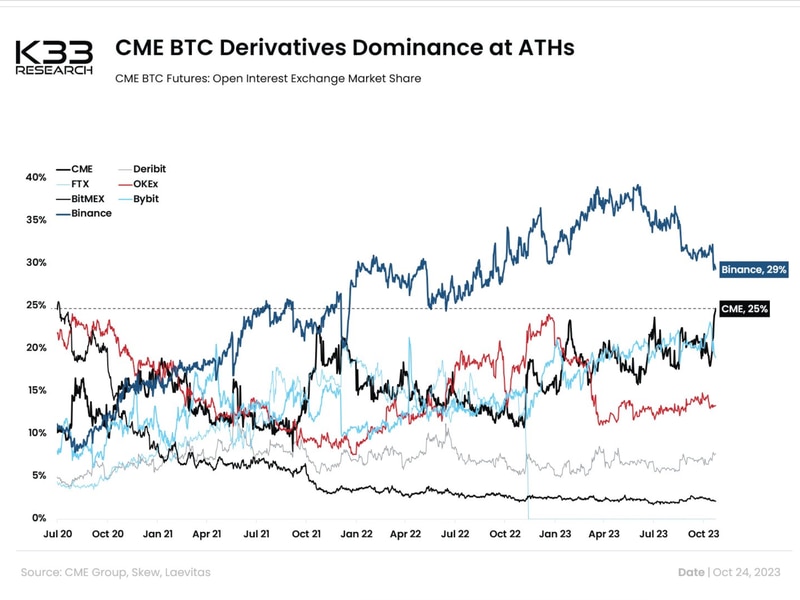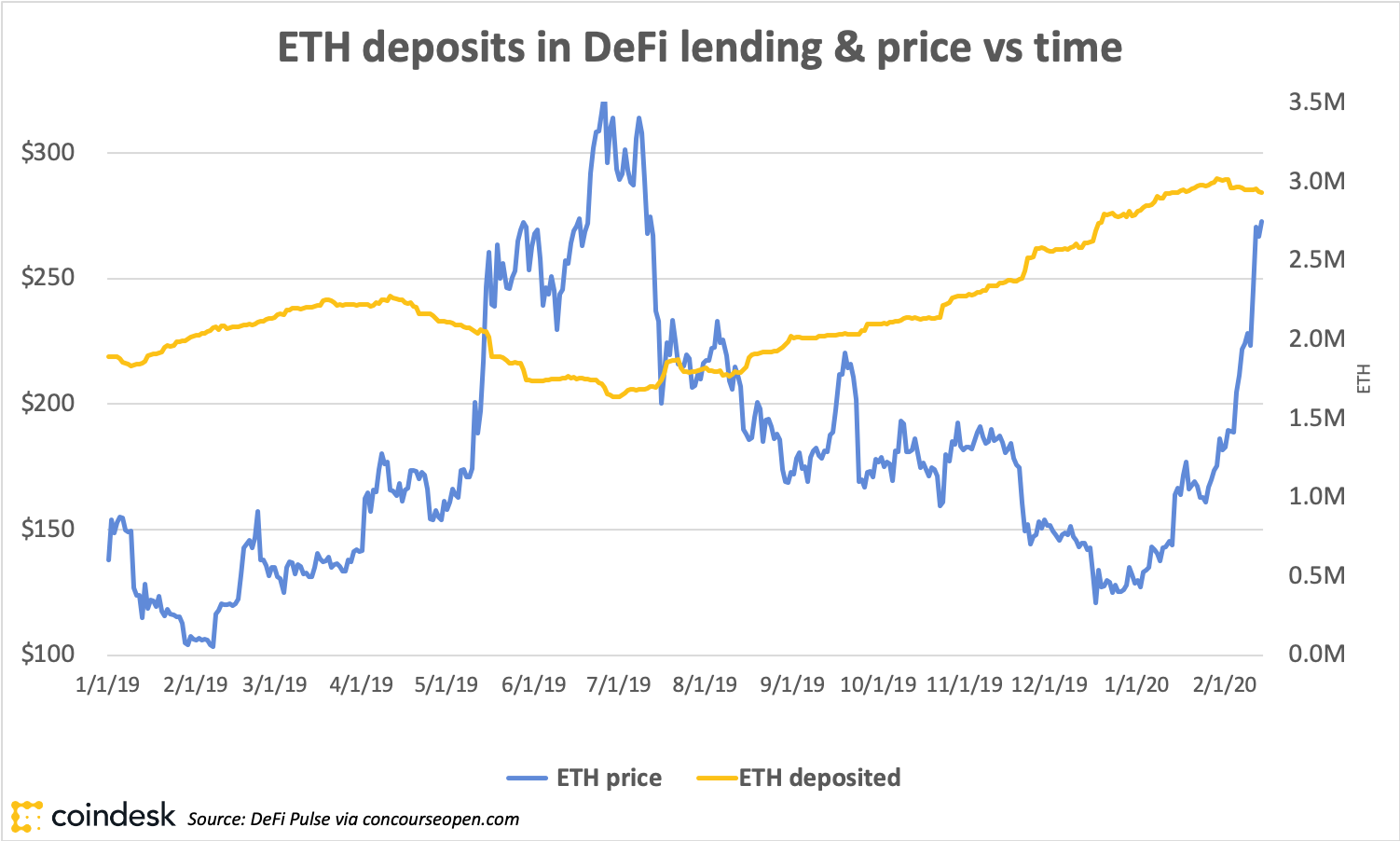The Protocol: Is Ethereum’s Dencun Update All It’s Cracked Up To Be?
/arc-photo-coindesk/arc2-prod/public/LXF2COBSKBCNHNRE3WTK2BZ7GE.png)
The main news this week centers around today’s Ethereum upgrade, Dencun, which marks the blockchain’s biggest technical shift in over a year. As CoinDesk’s Margaux Nijkerk reports, the upgrade could help slice fees for Ethereum users through “proto-danksharding,” an upgrade that’s designed to optimize the network for layer 2 (L2) rollup networks like Optimism and Arbitrum. On the other hand, some developers warn that the shift could fragment the Ethereum ecosystem and set it down a path that risks costing it its competitive edge versus competing chains.
In this week’s issue of The Protocol:
-
Developers are debating whether Dencun will be a good or a bad thing for the Ethereum network.
-
Investors and builders are breathing new life into DePIN networks that merge the physical and blockchain worlds to deliver on crypto use cases.
-
Legacy financial institutions like MasterCard, Goldman Sachs and BNY Mellon are continuing their march into the blockchain domain through new crypto partnerships and pilot programs.
-
Top picks from the past week’s
Protocol Village
column: Swell, Polygon, EigenLayer, Vega Protocol, Nibiru, Rarimo, Burnt Banksy, XION.
-
Over $160 million of blockchain project fundraises.
This article is featured in the latest issue of The Protocol, our weekly newsletter exploring the tech behind crypto, one block at a time. Sign up here to get it in your inbox every Wednesday. Also please check out our weekly The Protocol podcast.
Network news
ETHEREUM UPGRADES: Ethereum’s biggest upgrade in over a year has finally happened. The update, Dencun, contains a slate of code changes designed to improve Ethereum for developers and make it quicker and cheaper for end-users. The main one that people are paying attention to is “proto-danksharding,” which will allow abstract “blobs” of data to be posted to Ethereum alongside plain-old transactions. The idea of adding new lanes to the Ethereum highway via “sharding” is not a new one, but this first stab at the technique zeroes in specifically on decreasing fees for the “layer 2” chains that are rapidly becoming the primary venues by which people transact on Ethereum, which has seen its fees soar in recent years with rising network traffic. Developers hope the change will ramp up capacity on the network, allowing L2 blockchains like Arbitrum, Optimism and Coinbase’s Base network to post larger volumes of data to Ethereum without paying an arm and a leg to do so. While blobs could help slice gas fees for L2 users, there remains some uncertainty around the extent to which proto-danksharding will ease the chain’s fee woes: As any city planner will warn Ethereum’s core developers, adding lanes to a highway (or “shards”https://www.coindesk.com/”blobs” to a blockchain) may not ease congestion as intended. Some developers have also voiced concern that Ethereum’s embrace of L2s and native “data availability” risk fragmenting the ecosystem, and could lose the base chain its competitive edge versus rival networks.
GOING DEEP IN ON DEPIN: Speeds are improving and fees are reducing across blockchains, but we’re 15 years into the crypto “revolution” and few use cases have caught on outside of the narrow realms of memecoins and finance. One of the major trends helping to expand the crypto conversation beyond DeFi and infrastructure is “decentralized physical infrastructure networks,” or DePIN, which meld the physical world with blockchains to accomplish everything from easing supply chain inefficiencies to deploying unused compute resources. Projects that bridge blockchains with physical goods are nothing new: Helium, one of the more (in)famous examples of a DePIN project, is trying to create a wireless network that rewards contributors for setting up WiFi hubs. Filecoin, a veteran data-storage blockchain, rewards people for lending their unused hard drive space and remains a go-to example of how blockchain tech can solve real-world problems. The DePIN moniker was on the tip of everyone’s tongue at last week’s ETHDenver conference, but one might be tempted to wave it away as yet another marketing term meant to entice investors and users to tired ideas. But things have changed recently in the DePIN space, with improved blockchain tech and AI hype – buoyed by a surge in investor dollars – fueling the rise of newer projects like the compute-focused Akash and Render networks. If nothing else, the DePIN space is one to keep an eye on because it could help present an answer to an age-old question that has plagued crypto since its inception: Where are the use cases?
-
Kamino Finance
revises the point-earning rules
for its KMNO token airdrop in response to community backlash, promising additional rewards for long-term users, though the specifics of the changes remain undisclosed.
-
Goldman Sachs, BNY Mellon and more than a dozen other banks, custodians, and crypto firms are working with bluechip financial blockchain provider Digital Asset to
pilot a program
for tokenized asset transference and settlement.
-
PancakeSwap, the decentralized exchange, unveils a
new version
that it says is designed to make trading more efficient.
Protocol Village
Top picks of the past week from our Protocol Village column, highlighting key blockchain tech upgrades and news.
-
Ethereum staking protocol Swell has introduced a layer-2 rollup with $1 billion in total value locked (TVL) using Polygon’s chain development kit (CDK). Swell developed the rollup alongside Ethereum scaler AltLayer and a16z-backed crypto staking project EigenLayer. The rollup will take the form of a “restaked rollup,” which comes with a range of services such as decentralized sequencing, verification and faster finality, Swell said on Wednesday.
-
Vega Protocol, a purpose-built blockchain for decentralized derivatives trading, is launching the first futures markets for “points,” according to the team. The first markets are for EigenLayer points, with more expected soon. Vega uses UMA’s Optimistic Oracle to resolve each points market at the time of the “Airdrop Event,” which triggers settlement and determines the price per point. Users can assert claims to the oracle, which are verified on-chain if undisputed. This decentralized framework enables complex market rulesets without relying on a single centralized custodian.
-
NibiruChain, a layer-1 blockchain built by founders from Google, Tendermint, IBM and Sommelier, is announcing the launch of its public mainnet, according to the team: “Nibiru aims to address users’ onboarding challenges and provide a fully mainstream decentralized multichain solution. It is capable of processing 40,000 TPS with instant finality, made possible through parallel optimistic execution.” Smart contracts on Nibiru are written in Rust CosmWasm, which runs in the WebAssembly runtime, according to the project’s documentation.
-
Members of the Rarimo community, a digital identity protocol, revealed that “Russia2024 is the first use case of the recently launched Freedom Tool, an open-source solution for citizen-run, surveillance-free elections and polling.” According to the team: “Russia2024 is an encrypted polling app allowing dissenting Russian citizens to sign petitions, vote in polls and participate in protest elections without being traced. As a Freedom Tool application, Russia2024 uses zero-knowledge cryptography servers to ensure the safety and anonymity of its users, and votes are published directly onto the blockchain where they are tamper-proof. It was announced by opposition activist Mark Fegyin.”
-
Burnt Banksy announced the launch of XION’s mainnet, “the first blockchain purpose-built for mainstream adoption and the first to use USDC, a fully-reserved digital dollar, as its primary transactional currency,” according to the team: “The announcement was made as part of Burnt’s exclusive performance in New York, during which the founder lit himself on fire and subsequently set XION aflame, symbolizing a new light for the crypto industry.”
:format(jpg)/cloudfront-us-east-1.images.arcpublishing.com/coindesk/WIEAM6KLXNEGLC4YSYOXQEF5OI.jpg)
Image shared by a rep of Burnt Banksy’s performance at XION blockchain launch in Brooklyn on Wednesday. (Burnt Banksy)
Debating Dencun: Will Ethereum’s Big Update Help or Harm the Network?
:format(jpg)/cloudfront-us-east-1.images.arcpublishing.com/coindesk/CHMHMK6ADVHNHKTQLAUJ7HFMBA.png)
Ethereum’s biggest update in over a year, Dencun, finally arrived on Wednesday after years of planning. It’s seen as a good thing. But maybe not universally so.
Proto-danksharding, the main change coming with the Dencun update (a portmanteau of two simultaneous updates: “Deneb” and “Cancun”), marks Ethereum’s first step down the road of “sharding,” a method for increasing the chain’s transaction capacity by adding new lanes to its proverbial blockchain highway.
The feature is specifically aimed at reducing fees for layer 2 “rollup” networks – chains like Optimism, Arbitrum and Coinbase’s Base network that run on top of Ethereum and offer users the ability to transact for cheap without leaving the ecosystem entirely.
While many developers are celebrating Dencun for its potential to accelerate Ethereum towards improved affordability, others worry that it risks setting the ecosystem down a path that could, in the long run, come back to bite it.
“The Dencun upgrade is Ethereum’s response to clear needs for greater scalability,” Rich Rines, an initial contributor at Core DAO, which develops blockchain infrastructure, said in a message to CoinDesk. With Dencun, Ethereum is “focusing on empowering Layer 2 solutions,” but “questions remain whether this is a long-term fix.”
Money Center
:format(jpg)/cloudfront-us-east-1.images.arcpublishing.com/coindesk/55I2CHRE4FEBRITLWGMIG5AISI.jpg)
Rand Hindi, CEO of Zama (Zama)
-
Open-source cryptography firm Zama has raised $73 million in Series A funding to develop applications based on fully homomorphic encryption (FHE), a technology that enables data to be processed without decrypting it – potentially useful for protecting privacy in blockchain and AI. The funding round was led by Multicoin Capital and Protocol Labs, Zama announced via email on Thursday. Participating investors included Solana co-founder Anatoly Yakovenko, Filecoin founder Juan Benet and Ethereum and Polkadot co-founder Gavin Wood, according to a press release.
-
Eclipse Labs, the company building a blockchain to scale Ethereum using parts from Solana, raised $50 million ahead of its mainnet debut, which should come within weeks. According to the story by CoinDesk’s Danny Nelson: “Eclipse seeks to use a mix of technology from Solana, Celestia, Ethereum and RISC Zero for its proposed scaling solution – basically, speed like Solana with security provided by Ethereum. Apps built for Solana will be able to run on Eclipse with minimal changes, with SOL being the token of the realm.”
-
Fjord Foundry, a
token-sale platform
, has raised $4.3 million in a seed round led by Lemniscap, with participation from Mechanism Cap, Zee Prime Cap, Castle Capital and various renowned angels, according to the team: “Fjord offers a host of token sale methods, including its
Liquidity Bootstrapping Pools (LBPs)
, which prioritize equitable distribution, mitigating the risk of whale manipulation and bots. The round comes as Fjord is preparing to announce all-inclusive chain aggregation and the upcoming launch of its native utility token FJO.”
-
Cleartoken, a cryptocurrency clearing house, has received over $10 million in seed investment from institutional investors including Nomura, GSR and LMAX Digital, the company said Wednesday.
-
Elixir, a decentralized network that improves liquidity across orderbook exchanges, completed an $8 million Series B funding round, “bringing the project’s valuation to $800 million,” according to the team.
-
Bluwhale, a San Francisco-based AI-powered platform designed to connect companies with Web3 wallet holders, disclosed that it raised $7 million in seed funding.
-
NFTfi, a peer-to-peer, decentralized lending protocol for loans collateralized with NFTs, has raised $6M in a Series A1 fundraising, led by Placeholder VC, bringing total funding to $15M, according to the team.
-
New York-based Blackwing, founded by ex-Meta and Robinhood vets, raised $4.5 million, led by Hashed VC and gumi Cryptos Capital, according to the team.
-
Ethereum network revenue
surges to nearly two-year highs
as a speculative frenzy around meme coins boosts trading activity, per IntoTheBlock. Retail traders have caused Ethereum-based meme tokens such as pepe (PEPE), shiba inu (SHIB) and floki (FLOKI) to more than double in price.
-
Optimism, the Ethereum layer 2 scaling solution,
sells $89 million worth
of its OP governance tokens in a private transaction to an undisclosed buyer, with the tokens vesting over two years.
-
Solana-based DeFi protocol Kamino
announces it will airdrop
its KMNO governance token in April, with the amount distributed based on users’ accumulated points from using Kamino’s products.
-
Ether.Fi, the liquid restaking protocol on Etheruem, is set to introduce its long-awaited ETHFI token on Binance Launchpool next week.
-
Domo, the pseudonymous creator of Bitcoin’s Ethereum-inspired BRC-20 tokens, addresses thorny blockchain governance issues by partnering with two former sparring partners to co-maintain the protocol.
-
Ethereum network revenue
surges to nearly two-year highs
as a speculative frenzy around meme coins boosts trading activity, per IntoTheBlock. Retail traders have caused Ethereum-based meme tokens such as pepe (PEPE), shiba inu (SHIB) and floki (FLOKI) to more than double in price.
-
Optimism, the Ethereum layer 2 scaling solution,
sells $89 million worth
of its OP governance tokens in a private transaction to an undisclosed buyer, with the tokens vesting over two years.
-
Solana-based DeFi protocol Kamino
announces it will airdrop
its KMNO governance token in April, with the amount distributed based on users’ accumulated points from using Kamino’s products.
-
Ether.Fi, the liquid restaking protocol on Etheruem, is set to introduce its long-awaited ETHFI token on Binance Launchpool next week.
-
Domo, the pseudonymous creator of Bitcoin’s Ethereum-inspired BRC-20 tokens, addresses thorny blockchain governance issues by partnering with two former sparring partners to co-maintain the protocol.
-
U.S. President Joe Biden
proposes a budget
that includes a crypto mining excise tax and the application of wash trading rules to digital assets, aiming to generate significant revenue and address environmental concerns associated with crypto mining.
-
Former U.S. President Donald Trump
expresses a more constructive view
towards Bitcoin on CNBC, acknowledging its widespread use and suggesting it has become an “additional form of currency,” marking a significant shift from his previous stance where he labeled Bitcoin as a “scam.”
-
Coinbase, the largest U.S. crypto exchange, has
filed a lawsuit
against the U.S. Securities and Exchange Commission (SEC), accusing the agency of acting arbitrarily and capriciously by refusing to establish clear rules for the oversight of the crypto industry.
Data Corner
Digital asset investment funds experienced a significant surge in weekly inflows this week, reaching a new record of $2.7 billion and bringing the total for the year to $10.3 billion, as reported by CoinShares. This influx has primarily been driven by Bitcoin (BTC), which contributed $2.6 billion to the week’s total. According to CoinShares, the new inflows mean the industry could potentially surpass its record annual inflow of $10.3 billion set in 2021, all less than three months into 2024. U.S.-based spot ETFs have been actively acquiring thousands of Bitcoin coins daily, coinciding with a major price rally that saw Bitcoin reaching a new all-time high of over $72,000. Additionally, Solana (SOL) saw inflows topping $24 million last week, indicating broadening interest in cryptocurrencies beyond just Bitcoin.
:format(jpg)/cloudfront-us-east-1.images.arcpublishing.com/coindesk/G6W4LNQSYJDZTLE66DZ533YHCQ.png)
Calendar
-
June 11-13:
Apex
, the XRP Ledger Developer Summit, Amsterdam.
-
July 8-11:
EthCC
, Brussels.
Edited by Bradley Keoun.









